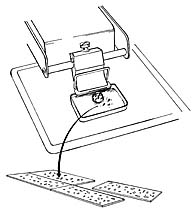- 泽任订制
- FST动物实验器械
- 瑞士ideal-tek镊子
- 瑞士Dumont镊子
- Weller
- Techni-Tool
- 瑞士Rubis镊子
- arosurgica
- Genesee Scientific
- Gilder Grids
-
Entegris
- WEICON
- ACCURIS
- AIMS
- RMC钻石刀
- Sipel镊子
- 德国WIHA
-
Si-Mat
- Jokari
- Circuitmedic
-
Glissando病理切片扫描仪
- KNIPEX(凯尼派克)
- Swann-morton
- Cellpoint Scientific
- Swanstrom
- All-spec
-
新华器械
- Excelta
- MENDA
- MEISEI
- Erem
- Regine
-
OPTRASCAN病理扫描仪
- Benchmark
-
IDEAL
- 大龙仪器
- 五洋医疗
- Hozan(宝山)
- 3M
- Stoelting
- Roboz
-
Diatome钻石刀
- Fine Science Tools
- PLATO
- NanoSoft
-
Avantama
-
PSI打击器及配件
- Aptum
- xuron
- SPI
- ASI Instruments
-
上海一恒
-
上海雷磁
- Quantifoil
- 上海方需
- 苏州六六
-
Hamilton
- ISMART
-
显微镜
-
Bonllmann
- AVEN
- 塔望科技
-
瑞典Haglof激光测距仪
- STILLE
-
美国安维迪
- 德国贝朗蛇牌
- Medline
-
蛋白纯化系统
-
OHAUS奥豪斯
- 康博特森
- Ossila
-
赛宁(苏州)生物
- Bernstein
- 洁盟清洗机
- Ted Pella
- DSI
- Keller
-
Smart Tweezers
- 瑞士PB
-
Microscopes Internat...
- Lattice Gear
-
凯氏定氮仪
- lindstrom
- 美国EMS
-
1-material
-
仪器
- realisticflies
- Boive
- Zivic
ACLAR® Film
ACLAR® Film provides an oxygen barrier when flat embedding specimens for electron microscopy and light microscopy,
it separates easily from epoxy and is chemically inert
|
Epoxy embedments sandwiched between ACLAR® sheets
 Disc Punches are available in four sizes: 5/16" (7.9mm) 3/8" (9.5mm) 7/16 (11.1mm) 1/2" (12.7mm)
 Press between glass plates  Fresh material is cut on a vibratory slicer, treated with HRP and placed on ACLAR® cut into a slide shape - observe under LM - if OK, process for TEM on the slide. |
The 1968 paper1 by E. B. Masurovsky and R.P. Bunge was the first to describe and clearly demonstrate the useful chemical and physical properties of ACLAR® for both tissue culture and electron microscopic purposes. It was first used in the space program and its properties were found to be interesting for biomedical research (personal communication, Dr. E. Masurovsky). Subsequent work by others developed ACLAR® applications; attention is brought to that done by Mawe, et al 2, and the comprehensive ACLAR® study by Kingsley and Cole3. ACLAR® overcomes a number of problems regarding the processing of tissue culture cells, epoxy embedments, sectioning and observations because of its chemical inertness, non-stick property, glass clarity, flexibility and smooth surface. It may be cut with scissors or blades and does not damage microtomy knives. It is unsurpassed in moisture barrier protection, transparent to UV and is plasticizer and stabilizer free. It is nonflammable, nonaging and has a low dielectric constant and dissipation. It is high in dielectric strength. ACLAR® can be sterilized. Features of ACLAR® Film:
ACLAR® is offered in sheet form, 8 x 12.5" (203 x 318mm) with 7.8 mil (0.2mm) thickness.
References, ACLAR® Film 1. Masurovsky EB, Bunge RP: Fluoroplastic coverslips for long-term nerve tissue culture. Stain Technology, 43, 3, 161-165 (1968) 2. Mawe GM, Bresnahan JC, Beattie, MS: Ultrastructure of HRP-labelled neurons: a comparison of two sensitive techniques. Brain Research Bulletin, 10, 551 (1983) 3. Kingsley RE, Cole NL: Preparation of cultured mammalian cells for transmission and scanning electron microscopy using Aclar film. J of Electron Microscopy Technique, 10, 77-85 (1988)
ACLAR® Embedding Film
Physical Data
|
| Density | 2.12 |
| Thickness | 7.8 mil (0.198mm) |
| Clarity | Clear |
| Water Absorption | nil |
|
Water Vapor Transmission Rate @ 100°F (37.7°C) / 100% RH |
0.003gm / 100in² / day (0.047gm / m² / day) |
|
Dimensional Stability, 10 min @ 300°F (149°C) |
<2% |
|
Dimensional Change, 10 min. @ 300°F (149°C) |
< 2% |
| Thermal Conductivity | 4.7 x 10-4 cal-cm/cm²sec °C |
| Crystalline Melting Point |
395.6 - 399.2°F (202 - 204°C) |
| Flammability | Nonflammable |
Chemical Resistance Data
| Acetone | No effect |
| 100% Ethyl alcohol | No effect |
| Liquid Nitrogen | Remains flexible |
| Osmium Tetroxide | No effect |
| Propylene Oxide | No effect |
| Butyl Alcohol | None |
| Carbon Tetrachloride | Slightly flexible |
| 1,2-Dichloroethane | None |
| Ethyl Acetate | Very flexible |
| Ethyl Ether | Very flexible |
| Ethylene Oxide | Very flexible |
| Formic Acid | None |
| Gasoline | None |
| All Acids (HCl, H2SO4..) | None |
| Methanol | None |
| Toluene | Slightly flexible |
| Plastisolve |
None |



